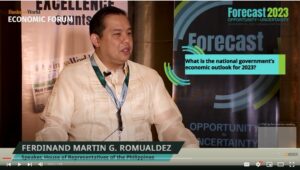Digital sector’s share to GDP dips in 2022

THE DIGITAL SECTOR’S contribution to the Philippine economy slipped in 2022, even as its gross value added (GVA) breached P2 trillion, the Philippine Statistics Authority (PSA) reported on Tuesday.
Citing preliminary data, the PSA said the digital economy contributed 9.4% to gross domestic product (GDP), equivalent to a GVA of P2.08 trillion, last year.
Its contribution to GDP last year was slightly lower than the 9.6% seen in 2021, and the smallest since the earliest available PSA data since 2018.
PSA data showed the digital economy, in absolute terms, grew by 11% or P205.44 billion last year from P1.87 trillion in 2021.
This marked the second straight year of growth after the sector contracted by 11.3% in 2021.
The latest PSA results showed that the digital economy has exceeded the pre-pandemic level of P1.96 trillion seen in 2019.
According to the PSA, the digital economy covers digital transactions such as e-commerce and online media/content.
Nicholas Antonio T. Mapa, senior economist at ING Bank N.V. Manila Branch, said the digital economy’s growth was quite healthy in 2022.
“We can explain the lower contribution to the overall GDP figure to the fact that the real economy (activities outside the digital economy) grew at a much faster pace,” he said in an e-mail.
The Philippine economy expanded by 7.6% last year, the fastest growth since the 8.8% reading in 1976.
Domini S. Velasquez, chief economist at China Banking Corp., said usage of digital technology is bound to increase.
“Traditional businesses continue to ramp up digitalization and the outlook for BPOs (business process outsourcing) remain robust, increasing demand for technology. The DICT’s (Department of Information and Communications Technology) thrust of improving e-governance in government transactions will also help drive the digital economy,” she said in an e-mail.
PSA data showed e-commerce posted the highest growth among the sub-components at 26.5% in 2022, quicker than the 8% in 2021. E-commerce’s share to the economy reached 20%, equivalent to P416.12 billion, in 2022.
Digital media and content grew by 11.8% last year, slightly faster than the 10.1% in 2021. Its contribution to the economy slightly increased to 2.8% or P57.41 billion.
On the other hand, digital-enabling infrastructure’s growth slowed to 7.5% last year from 7.8% in 2021.
Digital-enabling infrastructure contributed 77.2% or P1.6 trillion to the Philippine economy, slightly higher than the P1.49 trillion in 2021. This sub-component covers computers, electronic products, telecommunications services, among others.
In 2022, the number of Filipinos employed in the digital economy rose by 8.2% to 6.05 million from 5.59 million in 2021.
Nearly three-fourths or 4.67 million were employed by companies involved in digital-enabling infrastructure, followed by e-commerce with 1.23 million and digital media/content with 147,984.
Ms. Velasquez said trade tensions between the US and China may weaken electronic imports from China, which is part of the Philippines’ value chain, but this could also divert some US demand to the Philippines.
“Moving forward, there are some headwinds such as the planned imposition of value-added tax (VAT) on digital services and a weaker global outlook which will translate to tepid demand for semiconductors,” she added.
Finance Secretary Benjamin E. Diokno earlier said the proposed VAT digital service providers will generate P13.7 billion in revenues if implemented next year.
The measure has been approved by the House of Representatives but is still pending in the Senate. — Abigail Marie P. Yraola




